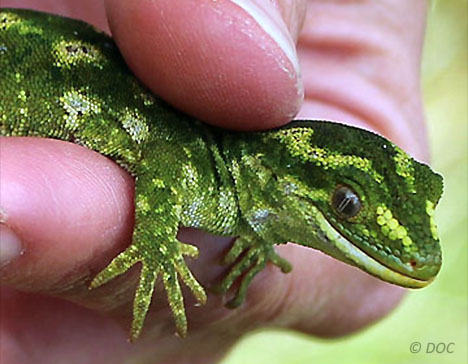Jewelled gecko
Status: Declining
Two main subgroups, one found in Canterbury and the other in Otago, with a small Southland population.

Description
The jewelled gecko (Naultinus gemmeus) mokomoko (Māori) is a small to medium-sized gecko up to 140-170mm long, with prehensile tails that can be as long as or longer than their bodies. Dorsal (back) surface markings are highly variable, either a series of white or yellow diamond-shaped patches or stripes down either side of the back. The belly (ventral) surfaces are grey, greenish or bluish, often with longitudinal streaks, and sometimes mottled. The mouth lining is blue, toe-pads narrow without expanded pads. Regional differences:
- Canterbury down to Lake Pukaki: some males are grey, brown or white, and females have brown flanks. The tongue is pink to dark grey with an orange tip.
- Otago: bright green backs and sides, the tongue is blackish, males more frequently striped than females
- Southland: plain green with canthal strip, however, the head is marked strongly.
More information

Conservation efforts
Poaching is one of the biggest threats for these spectacularly beautiful geckoes. Fines are up to $100,000 and 6 months jail. Poachers have been successfully prosecuted and jailed.
Note: trapping that removes larger predators such as weasels, ferrets, stoats, and cats has the potential to increase the population of mice, which can have a devastating effect on reptiles and invertebrates.
